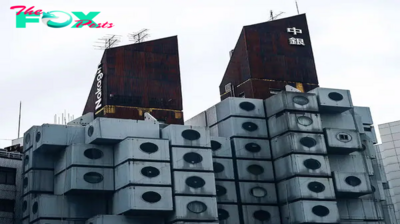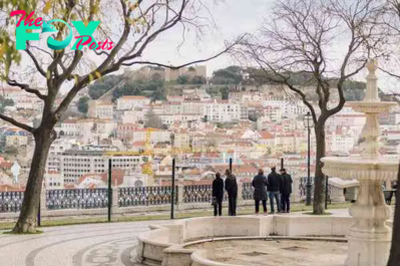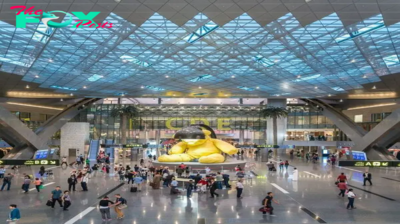Travel
16 Fun Things to Do in Lublin, Poland
If Lublin was a sibling, it would take a moment to appreciate its brothers and sisters in Krakow, Warsaw and Gdansk. But only for a moment. Lublin is too busy enjoying staying out of the limelight.
Lublin’s developing suburbs can create somewhat of a roadblock to discovering the best the city offers. But those who make the journey are rewarded with an intrinsic cultural fibre. One that exhibits a fascinating mix of local and Jewish history.

Although damaged in the Second World War, Lublin has risen again to protect what remained and recreate what was lost. Its Old Town has returned to its old self, presenting the timeline of the city. Elsewhere, you can uncover the city’s unheralded, but beautiful geography.
Contents:
16. Kraków Gate

Dating back to the 14th century, the Kraków Gate stands as a prominent feature of Lublin’s city walls. Its name pays homage to the historic royal route linking Kraków, Lublin, and Vilnius. Initially serving as a defensive structure, the gate later housed the clock-master and functioned as an observation tower for fire rescue.
Approaching the gate, its striking Gothic-style architecture commands attention, characterized by robust stone walls, a pointed arch entrance, and defensive towers.
The Kraków Gate underwent renovation efforts from 1959 to 1964. These works aimed to restore the gate to its original appearance while also modifying its interiors to accommodate the Museum of the History of Lublin. This museum exhibits artifacts detailing the gate’s historical significance, including its defensive role, architectural elements, and insights into medieval life in Lublin.
15. Pharmacy Museum

Immerse yourself in the rich history of medicine and pharmacy with a visit to the Pharmacy Museum in Lublin. Sitting in the heart of Lublin’s Old Town, this intriguing museum resides within an 18th-century tenement that once housed a functioning pharmacy.
Step inside and embark on a journey through time as you explore two meticulously curated rooms. The first room showcases antique pharmaceutical furniture alongside a fascinating array of historical glassware and tools used in pharmacies.
In the second room, delve into the laboratory and warehouse setting. Here, a collection of documents such as prescriptions and labels, as well as a diverse assortment of weights, provide further insight into the evolution of pharmacy practices over the centuries.
14. Saxon Garden

A serene haven away from the hustle and bustle of city life, the Saxon Garden is a picturesque park offering an ideal escape. Upon entering, visitors are greeted by lush greenery, vibrant flower beds, and meticulously maintained lawns, all designed in the classical English garden style.
Meandering paths, quaint bridges, and serene water features enhance the park’s charm. The focal point is a charming gazebo where visitors can relax and immerse themselves in the tranquil surroundings.
It’s the perfect spot for reading, contemplation, or simply enjoying the park’s natural beauty. During the summer months, the Concert Shell hosts musical performances, adding to the park’s draw and providing entertainment for all.
13. Crown Tribunal

Explore the era of the Polish-Lithuanian Commonwealth with a visit to the Crown Tribunal, a fascinating historical site located in the heart of Lublin’s Old Town. Formerly known as the Tribunal of the Crown, this historic building played a pivotal role in the legal and political history of the country.
It was originally constructed as the Old City Hall right after Lublin was granted a city charter in 1317. The Crown Tribunal has stood as a symbol of justice for centuries. Since 1578, it served as the highest court of appeal for the Crown of the Polish-Lithuanian Commonwealth, ensuring the rule of law and justice for all citizens.
Today, the Crown Tribunal houses the Wedding Palace and features a tourist path known as The Lublin Underground Route in its lowermost section.
12. Centre for the Meeting of Cultures

Experience the vibrant diversity and cultural exchange at the Centre for the Meeting of Cultures in Lublin. Established between 1974 and 2015, this institution serves as a dynamic venue. Here people of all ages engage with the arts, explore diverse cultures, and embrace new perspectives.
The center offers a range of facilities. These include a cinema, multiple theaters, and event spaces for exhibitions, concerts and forums. Notably, the center is renowned for its spectacular lighting facade, which illuminates the city with captivating patterns, images, and texts on various themes, delighting locals and visitors alike.
11. Plac Po Farze

In Lublin’s Old Town lies Plac Po Farze, a historic enclave preserving remnants of buildings dating back to the Middle Ages. Once graced by the church of St. Michael, Lublin’s inaugural parish, the square remains a prominent feature of the cityscape.
Although the church has vanished, its legacy endures through uncovered foundations and a bronze replica crafted in 2001-2002, recreating its historical appearance.
From the square’s edge, visitors are treated to a broad vista of eastern Lublin, where the valleys of the Bystrzyca, Czechówka, and Czerniejówka rivers converge. To the left stands Czwartek Hill, home to the ancient church of St. Nicholas, where traces of Lublin’s earliest settlement from the 7th century were discovered.
10. Day Trip to Zamość

For an unforgettable day trip from Lublin, Zamosc is a must-visit destination. This UNESCO World Heritage Site, located just an hour away, promises to enrich any traveler’s itinerary.
Zamosc stands as a unique Renaissance town, unlike any other in Poland or Central Europe. Founded by Jan Zamojski, the city was meticulously planned and constructed based on the Italian concept of a “perfect town”. Italian architect Bernardo Morando was enlisted to bring this vision to life, resulting in a stylish and cohesive town center that remains remarkably preserved today.
The centerpiece of Zamosc is its magnificent town hall and bustling Market Square, where well-preserved Renaissance buildings house charming cafes, restaurants, and shops. Immerse yourself in the lively ambiance, savoring local delicacies and browsing for souvenirs amidst the vibrant streets of Zamosc.
9. Lake Zemborzycki

A stone’s throw from the city center lies Lake Zemborzycki, affectionately known as “The Sea of Lublin” by locals. Its shores are teeming with recreational activities, featuring picnic spots, playgrounds, a rope park, and bicycle paths.
To fully appreciate Lake Zemborzycki’s beauty, consider renting a paddleboat, kayak, or canoe. These watercraft offer a leisurely exploration of the lake, allowing you to soak in the picturesque views and tranquil atmosphere. Whether you’re gliding on the water or exploring the shoreline, you’ll be enveloped in nature’s serenity.
For the more adventurous, Lake Zemborzycki provides opportunities for various water sports like windsurfing, waterskiing, and wakeboarding. Fishing enthusiasts can also enjoy casting their lines to catch the variety of fish species that inhabit the lake.
8. Grodzka Gate

Standing as a testament to the pre-war era, lies the historic Grodzka Gate. Alternatively known as the Jewish Gate, it harbors a profound symbolism. A passage between Lublin’s Christian and Jewish quarters, it’s a nexus of diverse cultures, traditions, and faiths.
Dedicated to preserving the memory of Lublin’s 43,000 Jewish inhabitants, the center holds an integral role in understanding the city’s pre-World War II period. This commitment is vividly illustrated by the conversion of a surviving street lamp from before the war into an eternal flame in 2004. Thus immortalizing the lasting impact of Lublin’s vanished Jewish community.
Found within the former Jewish Quarter, this eternal flame stands as an everlasting beacon, shedding light on the city’s history around the clock. Guided tours offered in multiple languages, including English, are conducted with passion and require prior appointments to ensure personalized experiences. A visit to this center is essential for a comprehensive exploration of Lublin’s rich cultural heritage.
7. Trinity Tower

Offering unmatched views of Lublin, the Trinity Tower is an integral part of the Lublin cathedral complex, dating back to the 17th century. Standing at 40 meters tall, its height may not initially impress, but the view from the tower’s summit is truly breathtaking. With its distinctive red-brick construction and Gothic architecture, the tower is a prominent feature on the city’s skyline.
Ascending the tower’s spiral staircase, visitors encounter various levels housing exhibitions showcasing the castle’s History and the city’s heritage. These exhibits provide a fascinating glimpse into Lublin’s medieval origins and its significance in Polish History.
Reaching the top of the Trinity Tower rewards visitors with a stunning vista stretching as far as the eye can see. From this elevated perch, you can admire the charming rooftops of Lublin’s Old Town, the winding streets, and the lively Market Square.
6. Lublin Cathedral

While in Lublin, a visit to the Lublin Cathedral is a must. Constructed between 1592 and 1617 by the newly arrived Jesuit Order, their legacy is evident in the street name ul. Jezuicka (Jesuit Street). This cathedral is among Poland’s earliest Baroque churches, drawing inspiration from Rome’s Chiesa del Gesù.
As you step into the cathedral, you’re enveloped in a sacred aura. Its interior echoes the grandeur of its exterior, featuring majestic vaulted ceilings, intricate polychromes, and elaborate altars. Illuminated by flickering candlelight and scented with incense, the atmosphere encourages contemplation.
Within the cathedral, explore the unique acoustic vestry, where whispers carry across specially designed vaults. Be sure not to overlook the treasury and crypts, which offer additional insights into the cathedral’s lasting legacy.
5. Fontanna Multimedialna

A delightful experience blending art, technology, and water to create a mesmerizing spectacle awaits at Litewski Square’s Fontanna Multimedialna. Also known as the Multimedia Fountain.
Upon arrival, the Fontanna Multimedialna’s modern design immediately catches the eye. The fountain presents a seismic display of water jets, lights, and music, choreographed to deliver a synchronized performance. This combination offers an engaging experience that is both dynamic and involving.
Complementing the water display is a diverse selection of music. These range from classical compositions to contemporary hits and enrich the overall atmosphere. The nightly shows start at 21:00 until the end of May and at 21:30 from June onward. Loved by tourists and locals alike, discover various themes from Lublin’s History through sound, water and light.
4. Open Air Village Museum

Situated in the valley of the Czechówka River, the Lublin Open Air Village Museum ranks among Poland’s largest open-air museums. Its expansive collection of architecture and exhibits, combined with a focus on preserving the intangible heritage of the region, illuminates the cultural diversity of the province.
From village life to manorial and small-town experiences, the museum displays items reflecting customs, rituals, traditions, and the daily life of past inhabitants. Segmented into sectors mirroring the landscape and ethnographic diversity of the Lublin region, it offers a comprehensive exploration of the area’s heritage.
Additionally, the museum hosts events and demonstrations throughout the year, showcasing traditional crafts, farming techniques, and cultural practices, providing visitors with an engaging and Educational experience.
3. Lublin Castle

Exploring centuries of history, visiting Lublin Castle is an insight into the grandeur of bygone eras. The castle’s imposing presence and fortified walls immediately command attention as you approach. Its medieval architecture, characterized by towers, battlements, and stone facades, evokes a time of knights and royalty.
Situated atop a hill, the castle offers expansive views of the city, offering a glimpse into Lublin’s rich past. With origins dating back to the 6th century, the Gothic castle was constructed in the 14th century under Casimir the Great.
Notably, in 1569, it hosted the parliamentary session leading to the Polish-Lithuanian Union of Lublin. Despite transformations over the centuries, including its role as a prison, the castle now serves as the seat of the Lublin Museum. It houses invaluable exhibits across archaeological, numismatic, ethnographic, and military departments, and stands as a testament to Lublin’s historical legacy.
2. Majdanek State Museum

A visit to the outskirts of Lublin offers a powerful and thought-provoking experience at the Majdanek State Museum. Situated on the former grounds of one of the largest Nazi camps in Europe, this museum serves as a solemn reminder of the atrocities of World War II.
Upon entering, visitors are enveloped in a somber atmosphere, reflecting the weight of the site’s history. The museum’s exhibits offer a comprehensive exploration of the camp’s dark past through photographs, artifacts, and personal testimonies, illuminating the experiences of victims and survivors.
The museum’s main exhibition, housed in the preserved barracks, provides insight into the daily lives of prisoners and the conditions they endured. Displays of personal belongings, documents, and images serve as a poignant reminder of the individuals who suffered within the camp’s walls.
1. Old Town

Discover a vibrant tapestry of History, culture, and architectural charm in Lublin’s Old Town. This UNESCO World Heritage site is the beating heart of Lublin. Wandering its cobblestone streets, you’ll encounter colorful facades and busy squares like Rynek, alive with cafes, shops, and local flair.
Architectural treasures blend Gothic, Renaissance, and Baroque styles, with Lublin Castle majestically overlooking the skyline. The district also houses the Lublin Museum, with diverse art and historical exhibits. You’ll also find the Crown Tribunal Museum within Lublin Castle, shedding light on the legal systems of yore.
Beyond its architectural splendor, the Old Town pulsates with cultural events, festivals, and concerts, immersing visitors in a vibrant tapestry of music, art, and entertainment.
Best Time to Visit Lublin

As the sun is shining brightest and the weather is warmest, May through to October is by far the most popular time to visit Lublin. During this period, average temperatures range from 13 to 24°C (55 to 75°F) and a staggering number of festivals take place.
Both July and August are the hottest, busiest and most expensive months. Tons of exciting events such as its modern art OpenCity Festival and traditional music Jagiellonian Fair more than make up for it though. This is also the best time to swim in the large Zemborzycki Lake or lounge along its sandy shores.
Either side of summer is a bit calmer and cooler which makes sightseeing more pleasant. As well as benefiting from slightly cheaper prices, spring and autumn are quite picturesque due to the colors of the flowers and trees. Lublin also sees less rain than during summer.
November to March is the low season when the city is cold, grey and snow sometimes falls. Around Christmastime, there is a spike in visitors as people head here to celebrate and enjoy the colourful decorations and lights brightening up its center.
Where to Stay in Lublin

In the heart of Lublin, the city center buzzes with life, offering easy access to attractions, dining, and entertainment. Staying here lets you dive into Lublin’s history and charm, surrounded by well-preserved buildings and quaint streets. Accommodation choices range from reclaimed hotels to modern apartments, catering to various tastes and budgets.
A favorite of ours, situated right by the city’s Old Town, is the IBB Grand Hotel. Notable for being housed in a beautifully restored century-old building. The hotel offers rooms designed for comfort and relaxation, each tastefully adorned with contemporary furnishings, luxurious bedding, and modern amenities. Situated just 650 meters from the Market Square, it provides an accessible and comfortable choice for visitors.
Located by the city’s promenade, Vanilla Hotel occupies a 17th-century historic building. With 18 individually designed rooms, each offering its own blend of comfort, space, and coziness, Vanilla Hotel ensures a memorable stay for guests. Conveniently positioned just 400 meters from the bus station and 2 kilometers from the railway station, it provides easy access to your time in Lublin.
How to get there

Easily accessible via various transportation options, Lublin has convenient Travel routes. Lublin Airport (LUZ) serves as a primary entry point, accommodating domestic and international flights. From the airport, Travelers can opt for taxis, ride-sharing services, or hotel shuttles to reach the city center.
Additionally, Lublin’s main train station, Lublin Główny, provides extensive rail connections to major cities in Poland and neighboring countries. Buses are also available, operated by several companies offering routes to and from Lublin.
For those driving, Lublin is linked to major highways. Once in the city, public transportation like buses and trams, alongside taxis and ride-sharing services, facilitates easy navigation.
Map of Things to Do Lublin
-

 Travel1d ago
Travel1d ago9 Best Places to Live in Ohio, According to Local Real Estate Experts
-

 Travel2d ago
Travel2d ago28 Hidden Wonders of the World
-

 Travel4d ago
Travel4d agoYou’ll Soon Be Able to Stay The Night in a Nakagin Capsule
-

 Travel4d ago
Travel4d ago9 Beaches in Hong Kong With the Most Stunning Views
-

 Travel5d ago
Travel5d agoThis New Airline Caters to Jet-Setting Pups
-

 Travel6d ago
Travel6d ago9 Best Places to Live in Portugal, According to Local Real Estate Experts
-

 Travel1w ago
Travel1w agoDoha’s Hamad International Airport Dethrones Singapore’s Changi Airport as the World’s Best
-

 Travel1w ago
Travel1w agoThe 7 Best Food Markets in Cape Town: Diverse Flavors of The Mother City

















